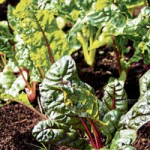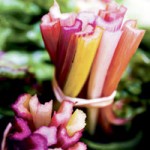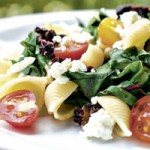Chard: A Bottomless Beet
Kaua‘i Kunana Dairy is a family owned and operated farm that raises goats, grows fruit and vegetables, and has beehives. Besides being certified organic, the farm earned an Animal Welfare Approved seal, in which a third party audits and certifies that the farm is raising its animals humanely, outdoors on pasture or range.
Kaua‘i’s only commercial cheese company produces artisan goat and feta cheese, and they are working on a line of aged cheeses that include Cheddar, blue, chevre sec and crottin. These cheeses should be ready in mid-August.
People on the east side of Kaua‘i now can buy Kunana’s products at the new Restore Kaua‘i Farmers Market, adjacent to the Kapa‘a Sunshine Market. Soon, Kunana will be offering a CSA (community supported agriculture) service and shares will be filled using their produce, cheese, baked goods and beauty products.
What’s growing now: Apple banana, avocado, basil (Italian, purple, Thai, cinnamon and sacred), beets, breadfruit, chard, cherry tomatoes, cilantro, collard greens, eggfruit, eggplant, eggs, fresh-eating turnips, grapefruit, Hawaiian chili peppers, honey, kale, Lisbon lemon, longan, lychee, Malabar spinach, mango, mountain apple, noni, okra, oranges, papaya, parsley, pomelo, purple kaimito, purple passion fruit, radish, romaine lettuce, salad mix, soursop, sweet corn, Tahitian seedless lime, tamarind, tangelo, tangerine.
CHARD
There are three types of chard: colored, perpetual and white-stemmed Swiss chard. These greens come from a variety of beets grown for its tops, not its root. The glossy leaves are wider and fatter than beet greens, and they have a distinctive but not sharp flavor and full-bodied texture.
Chard has been traced back to the Hanging Gardens of Babylon, some 30 miles south of Baghdad, which is the cradle of modern agriculture. It was a much-used vegetable in the ancient Arab world, and the Spanish dish of chard leaves with pine nuts and raisins is a residue of those Moorish origins.
Season: Chard is considered a winter green, and in Farm House Cookbook (Workman, 1991), author Susan Herrmann Loomis says it’s often referred to as Swiss chard because the leaves reputedly withstood harsh Swiss winters while its roots shriveled in the cold. On Kaua‘i, chard can be grown year-round, and takes about 60 days from seed to harvest.
What to look for: Look for plump, glossy leaves and sturdy stalks. Swiss chard has a milder flavor than red chard’s beet-like taste. The leaves can be extremely large, but this doesn’t mean they will be tough or lack flavor.
Storage: Use chard within a few days. Store in a plastic bag in the refrigerator until ready to use.
Preparation: The stems are typically braised while the leaves can be used in soups, braised, sauteed, steamed, with eggs, rice, lentils and in savory tarts. Large leaves can be stuffed or used as an outer wrap in replacement of tortillas.
In Provence and on the Ligurian coast of Italy, young stems and leaves are cut up and sauteed like spinach, and larger plants are steamed or boiled and dressed with a hollandaise sauce. Stems can be blanched and served like asparagus.
Chard pairs well with olive oil, butter, saffron, garlic, ginger, chili peppers, cilantro, basil, lemon, red wine vinegar, tomatoes, potatoes, chickpeas, pasta and eggs.
Tip: Treat the stems and leaves as two vegetables. With a sharp knife, trim the leaves from the ribs. Dice the stems and cut the leaves into ribbons about 1/4-inch wide. I like to saute the stems for three minutes over medium heat before adding the greens.
Health benefits: “Perhaps the gradual loss of vision in many older people is not an inevitable consequence of the aging process,” reports D. Max Snodderly, Ph.D., with co-authors Billy Hammond and Billy R. Wooten of their findings in Investigative Ophthalmology & Visual Science. “Improved nutrition could help to retard the loss of visual sensitivity with age.”
Green plants such as broccoli, green peas, kiwi fruit, chard and other leafy greens are lutein-rich foods.
“The highest accumulation of lutein in the body is in the eye,” says John Landrum, Ph.D., a leading researcher of the macular pigments of the eye. Lutein is concentrated in the central region of the retina, in a spot known as the macula lutea. The macula helps produce the sharp central vision needed for activities like reading, sewing and driving.
Kaua‘i Kunana Dairy products can be found at: Farmers Markets:
Waipa (Tuesdays at 2 p.m.), Restore Kaua‘i (Wednesdays at 2:30 p.m.), Kauai Community College (Saturdays at 9:30 a.m.) and Hanalei (Saturday at 9:30 a.m.) For more information, call 651-5046 or visit KauaiKunanaDairy.com.
KUNANA MARKET PASTA
I created this recipe using Kunana Dairy’s succulent chard, bright cherry tomatoes and creamy goat cheese. Typically, one bunch of chard weighs just over a pound, and the leaves cook down to about one cup. Save the stems and any extra leaves and add to omelets, rice, soups or stir-fries. Makes four servings.
1 pound shell-shaped pasta
1 cup chopped cooked chard leaves
2 cups cherry tomatoes, halved
1/2 cup sliced rehydrated sundried tomatoes
4 ounces Kunana Dairy Goat Cheese
2 tablespoons plus 3/4 teaspoon salt
3/4 teaspoon freshly ground pepper
While you bring a large pot of water to a boil, separate chard leaves from the stems. Cut leaves into 1/4-inch-wide ribbons and reserve stems for another use. When water is boiling, add 2 tablespoons of salt and pasta. Cook pasta according to package directions. One minute before the pasta is done, add the chard leaves. Drain and toss with cherry tomatoes, sun-dried tomatoes, pepper and remaining salt. Toss with goat cheese.
- Ryan and Sarah Wooton at the new Restore Kaua‘i market. Daniel Lane photos
- Chard takes about 60 days to grow
- Rainbow chard
- The Wooton’s bundles of chard weigh more than a pound
- Kunana Market Pasta. Daniel Lane photo








